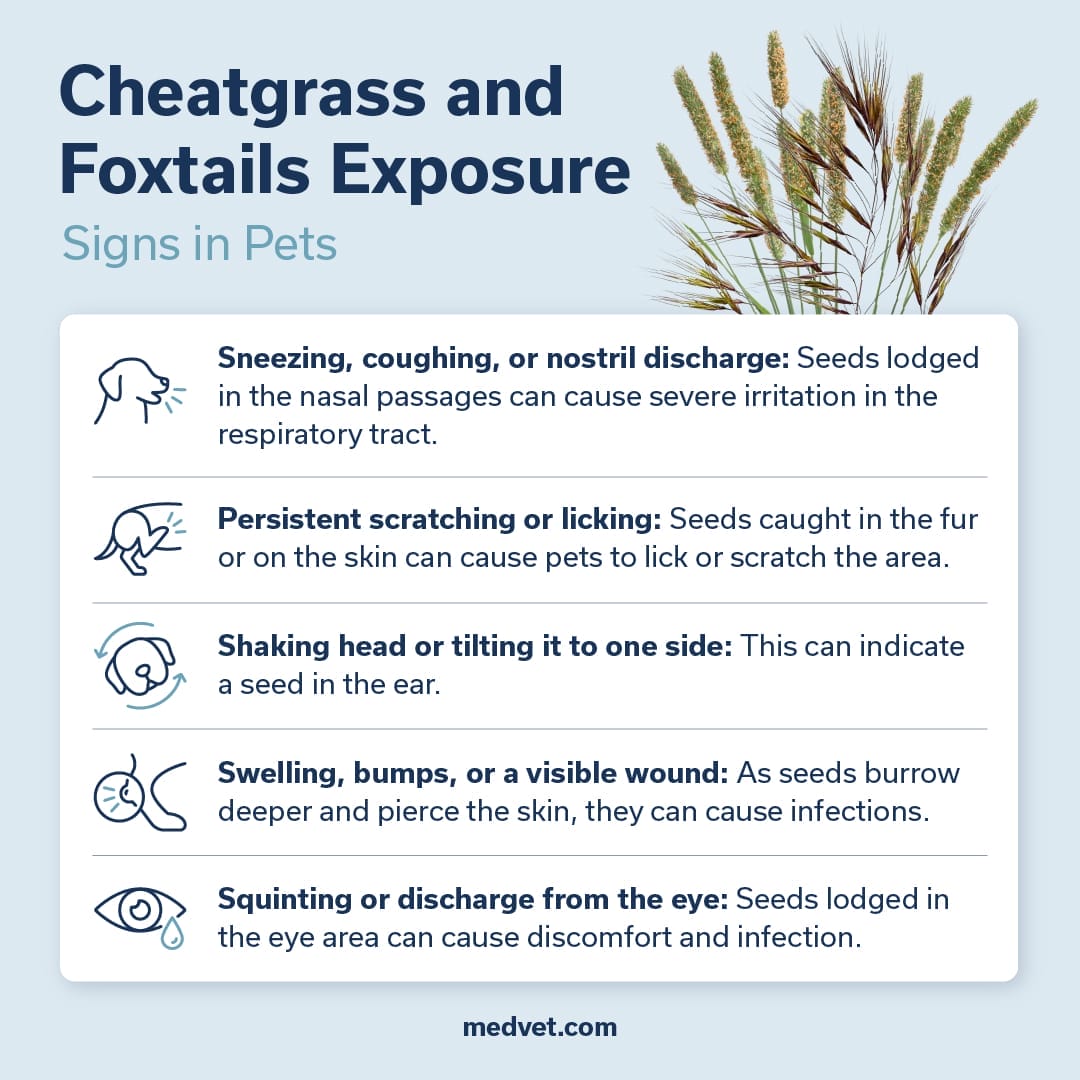
The Hidden Danger of Cheatgrass and Foxtails to Your Pets
Cheatgrass and foxtails are dangerous to pets. Learn signs your pet has been exposed, what you should do, and how to avoid them.
As the weather warms up in many parts of the United States, people and their pets are spending more time outdoors. While fresh air and sunshine encourage exercise and promote emotional health, there is a danger that lurks in many outdoor spaces: cheatgrass and foxtails. This seemingly innocuous plant can pose serious risks to your pet’s health. Here’s what you need to know about cheatgrass and foxtails and how to protect your pet from its dangers.
What are Cheatgrass and Foxtails?
Cheatgrass, also known as downy brome, and foxtails are both invasive grass species that pose significant problems in North America, particularly in the western states. Cheatgrass, known for its ability to rapidly spread and dominate landscapes, increases the risk of wildfires due to its dry and highly flammable nature during the hot, dry months. It has fine, hair-like awns (the bristly fibers that extend from the heads of the grass).
Foxtails, on the other hand, are notorious for their barbed seed heads that can embed into the skin of animals, causing severe irritation or infection. Foxtails are distinguished by their busy spikelet clusters that resemble the tail of a fox.
Both types of grasses share the problematic trait of thriving in disturbed soils, making them common in overgrazed or otherwise disturbed areas, where they often outcompete native vegetation and alter ecological balances. They typically dry out in the summer, and their seeds easily detach from the plant. These seeds burrow into the ground to ensure the plant’s reproduction, but this natural mechanism can cause harm to pets.

Why are Cheatgrass and Foxtails Dangerous for Pets?
The primary danger of cheatgrass and foxtails lies in their seeds, which can easily attach to your pet’s fur, especially if they have a long coat. These awns are barbed, making them difficult to remove once embedded. If not promptly and properly dealt with, they can burrow into the skin, ears, eyes, or even be inhaled into the nasal passages or lungs, causing severe infections, abscesses, and other health issues.
Dogs are particularly at risk because they often run through tall grasses and brush, where they pick up these seeds. However, outdoor cats and other pets can also be affected.
Signs Your Pet May Have Been Exposed to Cheatgrass or Foxtails
Cheatgrass and foxtails can cause a variety of signs in pets, depending on where the awns attach or embed. Here are some signs to watch for:
- Sneezing or coughing: Seeds can become lodged in the nasal passages, causing severe irritation in the respiratory tract, leading to sneezing, coughing, or even discharge from the nostrils.
- Persistent scratching or licking: If a seed gets caught in the fur or on the skin, pets will often lick or scratch the area incessantly.
- Shaking head or tilting it to one side: This can indicate a seed in the ear.
- Swelling, bumps, or a visible wound: Seeds can cause swelling or bumps as they burrow deeper, piercing the skin and causing infections.
- Squinting or discharge from the eye: Seeds can become lodged in the eye area, causing discomfort and infection.

What to Do if You Suspect Cheatgrass or Foxtails Exposure
If you notice any of the above signs and suspect that cheatgrass or foxtails are the culprit, follow these steps:
- Examine Your Pet: Carefully check areas where cheatgrass and foxtails are likely to get caught, including between the toes, under the belly, around the ears, and near the eyes.
- Remove Any Visible Awns: Using tweezers, gently pull out the awns. Be sure to check the direction of the barbs and pull accordingly to avoid breaking them.
- Clean the Area: If the awn has broken the skin, clean the wound with mild soap and water and apply an antiseptic.
When to Visit the Vet
If you are unable to remove the awns, or if your pet shows signs of infection (such as pus, excessive redness, or swelling), contact your family veterinarian. If they are unavailable, visit your local MedVet or emergency veterinary hospital. Additionally, if your dog exhibits any respiratory distress or continues to behave unusually after you’ve removed the awns, seek veterinary medical help.
Seeds can migrate quickly inside the body, and the sooner they are removed, the better. In some cases, surgery may be required to extract the seeds, especially if they have moved into the chest or abdomen.

Preventing Exposure to Cheatgrass and Foxtails
Prevention is key when it comes to protecting your pets from cheatgrass and foxtails. Here are some tips to help you protect your pet:
- Avoid high-risk areas: During its peak season (late spring to early summer), try to keep your pets away from areas where cheatgrass and foxtails are prevalent.
- Regular grooming: Brush your pet’s coat regularly to remove any seeds before they can burrow into the skin. Long-haired pets may benefit from a trim, especially during the cheatgrass and foxtails season to reduce the chances of awns attaching and embedding.
- Inspect your pet: After walks or outdoor activities, thoroughly check your pet’s coat, especially around the ears, eyes, and feet. Remember to check between the toes and under their collar.
- Maintain your yard: Keep your lawn mowed and remove any weeds to minimize the presence of cheatgrass and foxtails near your home.
While cheatgrass and foxtails may look harmless, they can cause significant discomfort and serious health issues for your pets. By understanding these plants and taking proactive steps to protect your pets, you can keep them safe and healthy.
Learn more ways to keep your pets safe during the summer.
FAQs
Why are cheatgrass and foxtails dangerous for pets?
How do I know if my pet has been exposed to cheatgrass or foxtails?
How do I help my pet with cheatgrass or foxtails exposure?
Learn More
For ways to ensure your pet lives a happier, healthier life, visit our Pet Care Resources library.
Pet Care ResourcesContents
Learn More
For ways to ensure your pet lives a happier, healthier life, visit our Pet Care Resources library.
Pet Care Resources


